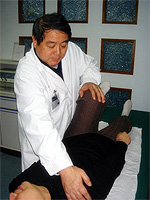Development of Massage Therapy in China
In China, massage is not simply regarded as a mean of relaxation but as an important component of traditional Chinese medicine. Its origins date back much earlier than many other therapeutic techniques and because of its simplicity and safety in application, as well as its effective results, it has evolved into its present popular form.
 |
 |
| Chinese massage is not simply regarded as a mean of relaxation but as an important component of traditional Chinese medicine. |
Prior to the Qin and Han dynasties (221 BC - AD220), massage had already been widely used as a treatment, and the first specialized work on the subject appeared during this period. Zhang Zhongjing (AD150-219), also known as a TCM "sage", first introduced the use of ointment during massage. This method (gaomo) consisted of smearing ointment on a particular area of the body, then using various massage techniques to achieve healing. This enhanced the overall therapeutic effect of the massage and also extended its range of application.
In the Southern & Northern dynasties (AD 420-581), Tao Hongjing wrote a book on health preservation and self healing, in which he detailed the use of massage, breathing and physical exercises for the maintenance of health. The author combined simple techniques like chewing, warm eye compresses, pressing the eyes, pulling the ears, combing the hair, brushing the face, and rubbing the body, evolving them into various forms of health-promoting exercise. This laid the foundation for the later development of "self-massage".
In the Sui and Tang dynasties (AD 581-907), massage therapy formally became a medical specialty. The Imperial Medical Academy authorized massage specialists to take charge of daily medical treatment as well as teach. At that time, knowledge of theories, clinical indications and treatment had all advanced a certain level that have subsequently shaped the practice of modern massage.
China was involved in continuous military activities during the Song and Yuan dynasties (AD 960-1368), and the resulting traumatic injuries facilitated the further development of massage, with massage techniques being incorporated into bone-setting therapies. And with the establishment of TCM pediatrics, special massage techniques were designed for childhood diseases. Massage specialists also began to practice martial arts in order to enhance their own physical strength and promote their skills. This resulted in the integration of massage, gym exercises and martial arts, and greatly influenced the later massage profession.
Massage flourished during the Ming dynasty (AD1368-1644), and massage practitioners were categorized as one of the thirteen medical professionals. A major breakthrough was in pediatric massage, with theoretical and clinical advances leading to independent system of pediatric diagnosis, techniques and protocols.
During the Qing dynasty (AD1644-1911), China went through a major breakdown in social, political and economic systems. Westernization had a significant impact on the practice of TCM. Despite some advancement in bone-setting massage, educated people increasingly refused to learn massage; the government suppressed its practice with the result that massage therapies gradually faded out of the mainstream; however, it still remained as a popular folk practice.
This situation changed after 1949, when the government decided to reorganize and promote the use of Chinese medicine, which meant that massage was once again considered a valuable therapy. Medical schools and hospitals re-established massage and bone-setting departments; they trained many specialists and carried out modern studies on massage to explore its therapeutic mechanisms.
|